Name the components of lac operon and discuss their role
Step-by-Step Solution:
1. Introduction to Lac Operon:
The lac operon is a genetic regulatory system found in bacteria, particularly in *Escherichia coli* (E. coli). It is responsible for the metabolism of lactose, a sugar found in milk.
2. Components of the Lac Operon:
The lac operon consists of several key components:
- Promoter (P): This is the site where RNA polymerase binds to initiate transcription of the operon.
- Operator (O): This is a segment of DNA that a repressor protein can bind to, preventing transcription of the downstream genes.
- Regulatory Gene (lacI): This gene produces a repressor protein that can bind to the operator.
- Structural Genes (lacZ, lacY, lacA):
- lacZ: Encodes the enzyme beta-galactosidase, which breaks down lactose into glucose and galactose.
- lacY: Encodes lac permease, which facilitates the transport of lactose into the cell.
- lacA: Encodes transacetylase, which is involved in the metabolism of lactose.
3. Role of Each Component:
- Regulatory Gene (lacI): Produces the repressor protein that binds to the operator. When lactose is absent, the repressor binds to the operator, preventing transcription of the structural genes.
- Promoter (P): Allows RNA polymerase to bind and initiate transcription when the operator is not blocked by the repressor.
- Operator (O): Acts as a control switch. When the repressor is bound, transcription is blocked; when it is not bound, transcription can occur.
- Structural Genes (lacZ, lacY, lacA):
- lacZ: Produces beta-galactosidase, which converts lactose into glucose and galactose for energy.
- lacY: Produces lac permease, which helps in the uptake of lactose into the bacterial cell.
- lacA: Produces transacetylase, which may help in detoxifying byproducts of lactose metabolism.
4. Induction of the Lac Operon:
When lactose is present in the environment, it enters the bacterial cell and binds to the repressor protein. This binding changes the shape of the repressor, causing it to release from the operator. As a result, RNA polymerase can bind to the promoter and transcribe the structural genes (lacZ, lacY, lacA), leading to the production of enzymes necessary for lactose metabolism.
5. Repression of the Lac Operon:
Once lactose is consumed and is no longer present, the repressor can again bind to the operator, blocking transcription and effectively turning off the operon. This allows the bacterial cell to conserve energy by not producing unnecessary enzymes.
The lac operon is a genetic regulatory system found in bacteria, particularly in *Escherichia coli* (E. coli). It is responsible for the metabolism of lactose, a sugar found in milk.
The lac operon consists of several key components:
- Promoter (P): This is the site where RNA polymerase binds to initiate transcription of the operon.
- Operator (O): This is a segment of DNA that a repressor protein can bind to, preventing transcription of the downstream genes.
- Regulatory Gene (lacI): This gene produces a repressor protein that can bind to the operator.
- Structural Genes (lacZ, lacY, lacA):
- lacZ: Encodes the enzyme beta-galactosidase, which breaks down lactose into glucose and galactose.
- lacY: Encodes lac permease, which facilitates the transport of lactose into the cell.
- lacA: Encodes transacetylase, which is involved in the metabolism of lactose.
- Regulatory Gene (lacI): Produces the repressor protein that binds to the operator. When lactose is absent, the repressor binds to the operator, preventing transcription of the structural genes.
- Promoter (P): Allows RNA polymerase to bind and initiate transcription when the operator is not blocked by the repressor.
- Operator (O): Acts as a control switch. When the repressor is bound, transcription is blocked; when it is not bound, transcription can occur.
- Structural Genes (lacZ, lacY, lacA):
- lacZ: Produces beta-galactosidase, which converts lactose into glucose and galactose for energy.
- lacY: Produces lac permease, which helps in the uptake of lactose into the bacterial cell.
- lacA: Produces transacetylase, which may help in detoxifying byproducts of lactose metabolism.
When lactose is present in the environment, it enters the bacterial cell and binds to the repressor protein. This binding changes the shape of the repressor, causing it to release from the operator. As a result, RNA polymerase can bind to the promoter and transcribe the structural genes (lacZ, lacY, lacA), leading to the production of enzymes necessary for lactose metabolism.
Once lactose is consumed and is no longer present, the repressor can again bind to the operator, blocking transcription and effectively turning off the operon. This allows the bacterial cell to conserve energy by not producing unnecessary enzymes.
Topper's Solved these Questions
- BOOK - ICSECHAPTER - SELF ASSESSMENT PAPER-1EXERCISE - Part-II (Section -C)12videos
SELF ASSESSMENT PAPER-1
- BOOK - ICSECHAPTER - SELF ASSESSMENT PAPER-1EXERCISE - Part-II (Section -A)9videos
SELF ASSESSMENT PAPER-1
- BOOK - ICSECHAPTER - SELF ASSESSMENT PAPER 9 EXERCISE - SECTION .C.12videos
SELF ASSESSMENT PAPER 9
- BOOK - ICSECHAPTER - SELF ASSESSMENT PAPER-4EXERCISE - Part-II (Section C)7videos
SELF ASSESSMENT PAPER-4
Similar Questions
Lac operon is
View SolutionRepressor of lac-operon
View SolutionInducer of Lac operon is
View SolutionThe lac operon consists of
View SolutionThe inducer of Lac operon binds to
View SolutionMatch the following genes of the Lac operon with their respective products.

Select the correct option .View SolutionName the three types of biotic components of an ecosystem and mention the role they.
View SolutionWrite the different components of a lac - operon in E . Coli Explain its expression while in an 'open' state.
View SolutionWrite the different components of a lac - operon in E . Coli Explain its expression while in an 'open' state.
View SolutionName the different components of xylem and draw a living component ?
View Solution

